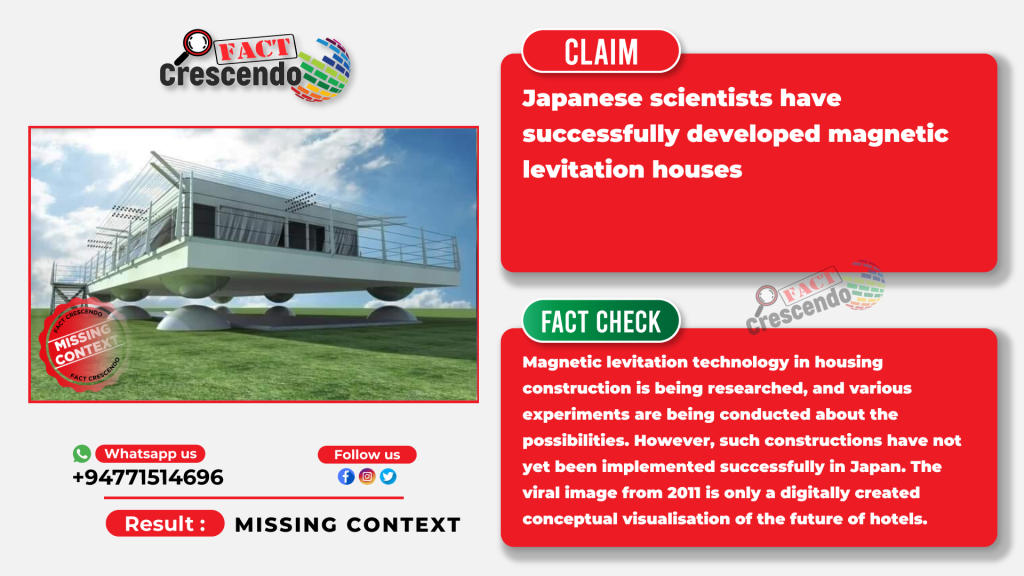
Located in a seismically active region, Japan is one of the most earthquake-prone countries in the world. As a result, the Japanese have implemented robust adaptation plans to mitigate the seismic impact, emphasising public safety and infrastructure resilience.
However, we came across viral misleading social media claims, which exaggerated the actual advancements the Japanese had made in the earthquake-resilient construction field. Let’s look at the claim first.
Social Media Posts
Social media posts suggest that using unique magnetic levitation technology, Japanese scientists have managed to build a house which would float in the air during an earthquake.
The claim is supported by an image showing a house floating without any foundation, as seen below, and this Sinhala language post has been shared over 16K times.

These posts were first shared in English, and below is a post from 2023 with the same claim: “Japanese scientists are planning to develop technology which will raise house bases from the ground and protect them from earthquakes.”

We decided to investigate the facts behind these claims and explore earthquake-resistant building technologies.
Fact Check:
Using keyword searches, we notice that the viral claims were an extension of posts which spoke of conceptual images of a company named ‘Air Danshin Systems’, established in 2005, specialising in using air to lift houses and reduce earthquake shaking. (air seismic isolation)
Air Danshin Systems’ Earthquake-Resistant Technology:

As explained by the diagram below, the house sits on a deflated airbag during more stable times. These homes have built-in sensors that continuously monitor seismic activity and tremors. When sensors feel a tremor, they switch on a compressor within a second. The compressor pumps air into an airbag, inflating it within a few more seconds and ultimately lifting the entire house a few centimetres off its supposedly earthquake-proof concrete foundation. There, the structure would then hover, meaning that its inhabitants could casually go about their business for the duration of the quake. Then, the airbag deflates, and the house gently settles back down.
More details about the functioning of Air Danshin’s system can be understood through a video demonstration, as seen here.
Real Scenario vs. Viral Image:
Therefore, the viral image circulating on social media, showing a house floating without any foundation, is misleading.
Real technology used by ‘Air Dashnin’ involves a controlled lift of houses during earthquakes, whereas the viral image suggests a magnetic levitation system. Therefore, it is crucial to distinguish between the actual technology developed by Air Danshin Systems and the misleading image, as they are unrelated.
The Viral Image Is A Digitally Created Illustration!
The image is a digitally created illustration from a 2011 hotel and tourism conference. It was not intended to represent real technology but was part of a conceptual visualisation for the future of hotels.

Advancements in the field of Maglev
Magnetic levitation, commonly known as maglev, is a technology used in Japan for transportation systems such as trains, which has had great success.
Also Read: පැයට කිලෝමීටර් 5000ක වේගයෙන් ගමන්ගන්නා දුම්රියක්?
While the idea of maglev houses is still in the conceptual stage and an area of research, it represents an innovative approach to addressing the unique challenges of housing construction in Japan, a country known for its frequent earthquakes and limited land availability. It will be interesting to see how this technology develops and whether it becomes a viable option for housing in the future.
Follow us and stay up to date with our latest fact checks.
Facebook | Twitter | Instagram | Google News | TikTok
Conclusion:
The use of Magnetic levitation technology in housing construction is indeed being researched, and various experiments are being conducted about the possibilities. However, such constructions have not yet been implemented successfully in Japan.
Furthermore, the viral image from 2011 is only a digitally created conceptual visualisation of the future of hotels. Social media users need to be cautious not to rely on misleading visuals when spreading information about technological advancements.

Title:Misleading Photo Goes Viral as Japanese Developing Floating Houses for Earthquake Protection! Find out the facts…
Written By: Kalana KrishanthaResult: Missing Context






